Mission: Impact podcast & blog
Build a better world without becoming a martyr to your nonprofit cause
Listen on:
|
Nonprofit funders expect your nonprofit organization to be able to demonstrate its impact. While there are many ways to approach this, building out your organization’s theory of change and your program level logic models is an important step. We will explore what a theory of change and logic model is, why it is important and how it can help your organization measure the impact of the work you are doing. Understanding the Nonprofit Logic ModelA logic model maps out what it takes to deliver a program, service or area of work within the nonprofit organization. It details the assumptions embedded within the program and its short-, medium- and long-term outcomes. It also visually maps the program building blocks including inputs, activities, outputs. With this mapped out, you then can design an evaluation process and system to capture data on whether the program is producing the expected outcomes. The logic model breaks out in more detail one element of an organizational level theory of change. For example, a local watershed organization may focus their work in three areas – education, citizen science and policy work – to further its mission of contributing to a healthy watershed. Each work focus area mapped out in the theory of change would then have its own logic model. What is a theory of change?A theory of change shows visually and in writing how your organization’s work connects to and moves your mission and vision forward. A logic model maps out what it takes to deliver a specific program, the assumptions embedded within it and its short-, medium- and long-term outcomes. Taking the time to work together to create both will make apparent gaps in logic, understanding and agreement about what you are trying to achieve within your organization. It provides you with the opportunity to work through these to come to a shared understanding and vision which strengthens your work and organization. 4 Steps to Building Your Logic ModelAfter you have worked collectively to create your organization’s theory of change, you can work on creating each work area, service, or program area’s logic model.
From Theory to Practice: Implementing Your Logic ModelOnce your logic model is complete, you can then decide what performance measures you will focus on and how you will collect data on those measures. These data do not all need to be quantitative. In addition to quantitative data collected through surveys, often qualitative data including gathering stories and experiences through interviews will be an important component of the evaluation design. Measuring and Mapping ImpactWith this process, there can be the temptation to start collecting data about everything and then get overwhelmed and over time the data gathering stops, or you have a lot of data that you do not have time to synthesize and make meaning of. Keep it simple and choose a few key items to track so that you have the time to do the truly important work – learning from your evaluation. What are you learning from your team conversations?As you collect data and synthesize it, you will learn more about the effectiveness of your program. You may identify areas in which your hypotheses were not entirely accurate. What can you learn from the information? Apply your learnings by adjusting the program. This may mean tweaking your logic model as new information is gathered. Communicating results to your stakeholdersThe information you gather will have many applications. In addition to reporting results internally to your staff and board as well as to funders, you might highlight results on your webpage, blogs, social media, and annual reports. As you are doing so, consider each audience and their interest and perspectives. What do they care about and how can you link what you are doing and your results to that? Ask this question for each audience as you decide what aspects of your results to share. Just producing one findings report misses many opportunities to tell your story and share your impact. Overcoming 3 Common Challenges to developing a logic modelNot connecting the theoretical processes to practical applicationThese processes can seem a little esoteric. It helps to have an evaluation facilitator help walk you through the process. One of the common sticking points is the difference between an output and an outcome. You are likely already tracking outputs – how many people showed up to a training or the number of times you have testified before government decision makers. But what are you expecting people to be able to do after the training – answering that question helps you start identifying outcomes. A facilitator can keep the conversation going, help everyone understand the purpose of each step and ensure all the items are captured s as the group brainstorms. Realistic expectations of what your data are telling youOther objections to engaging in this work have to do with whether you can prove your program, service or intervention is THE factor that creates the outcome. Organizations rarely have the resources to evaluate their programs at that level, including running double-blind tests. While you may not be able to invest in evaluation to the level that will enable you to prove your impact, you can design a system that help board and staff to continue to strengthen the program as well as gather evidence of your impact. Does not represent the full complexityAnother pitfall is rejecting logic models because they cannot fully capture the complexity of the system that program participants are living within or are themselves. Indeed, the map is not the territory. No model will fully capture life in its full complexity. Yet it can provide a slice of that reality that your work is focused on. With these understandings in mind, you can proceed with more realistic expectations for what a logic model, monitoring and evaluation can do for your organization. Nonprofit Logic models are worth the investmentInvesting the time in mapping out your organization’s theory of change and logic models is an important aspect of ensuring your stakeholders are aligned on your organization’s strategy. The process can reveal and then address gaps in logic, understanding and agreement on how each aspect of your work contributes to your overall mission. Tackling this as a collective project helps educate everyone involved not only about the process itself but also about why and how you do what you do. It can contribute to breaking down silos within your organization. With the information you collect because of this work, you are also better able to tell your story of results to donors, funders, board members, volunteers, community partners and decision makers.
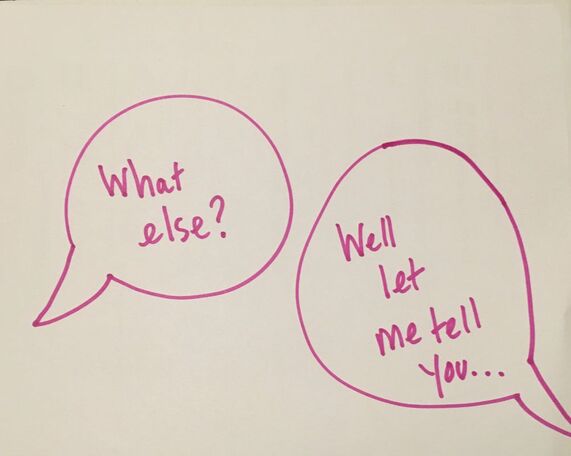 Through my strategic planning work I interview a lot of people. Most nonprofit consulting projects include some interviews or focus groups as part of the discovery process. I used to end my interviews with the question, “Is there anything else I need to know for this project/process?” Most of the time the answer would be, “no, nothing else.” Then one time I said, “What else do I need to know for this project/process?” And a whole lot more spilled out from the person I was talking with. “Is there anything else…?” “What else…?” doesn’t seem on surface to be very different. Yet it shifts the focus from a finite yes/no answer to the more open ended, “what else…?” And embedded in the question is the assumption that there is something else. Something else that I could not have anticipated in the questions I have already asked. Small tweaks can make a differenceIt seems like a little bit of a throw away. Yet often the most interesting and revealing answers are to that question.
So small tweaks can have a big impact. What small tweaks have you made recently in your work that had an impact? 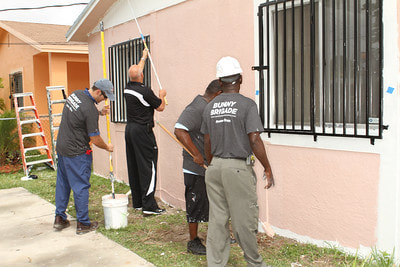 Photo by El Gringo, Miami Habitat for Humanity Photo by El Gringo, Miami Habitat for Humanity Your nonprofit organization is designed for a specific mission with the goal of having an impact in the world. The world will be different in some way because of the work you do. Homeless people are cared for and fed who wouldn’t be otherwise. First generation college students increase their understanding of financial aid so that they can make better decisions about paying for their education. They’d make costly mistakes without you. Emerging leaders in marginalized communities are supported to strengthen their self-awareness and skills so that they can advocate for their community. You undertake the activities and programs with the aim of furthering your mission. Have you taken the time to look at how all the pieces fit together and whether it all adds up? Creating a picture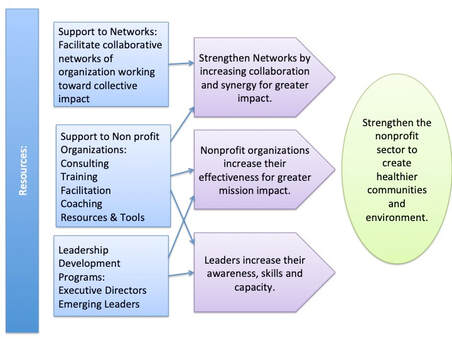 A sample impact map of a capacity building organization. A sample impact map of a capacity building organization. When you create an impact map also known as a logic model, you create a visual representation of what your organization is doing and how it creates the impact you want to have in the world. It makes clear how you leverage resources and organizational capacities to deliver your core strategies to achieve tangible results. By creating an impact map, you are able to create a model that illustrates your beliefs about the change you are trying to make. Identifying assumptions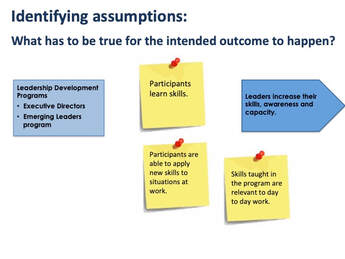 Sample outcomes and indicators. Sample outcomes and indicators. It also can help you uncover the assumptions inherent in your programs and activities. You can also describe what short, medium and long term outcomes you believe result from each program or activity. A good question for identifying assumptions is to ask, “what has to be true for this outcome to happen?” These essentially are the hypotheses embedded in your program design. Are there gaps in logic?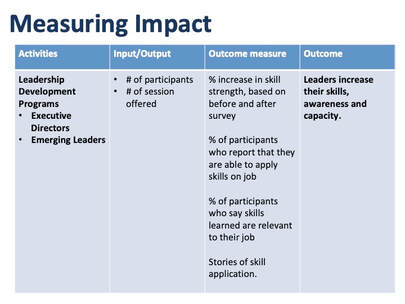 Are you measuring inputs and outputs or outcomes? Are you measuring inputs and outputs or outcomes? Once you have created your map and identified the assumptions inherent with each program, you can consider how you might measure whether you are having the mission impact you are aiming for. An impact map can also uncover gaps in your logic. Creating shared understandingEngaging in the process of impact mapping can be a useful exercise for staff and/or your board. Have small groups create an impact map of your organization. Then compare the maps. Do people envision the same organization? Where are the gaps in knowledge and understanding?
Once you have agreement on your organization’s impact map, take it one step further. Have a conversation about the implications of the map. Ask questions such as:
Think this might be helpful for your organization and would like some help? Inquire about a coaching session.  Every nonprofit organization development and strategic consulting project begins with a discovery stage. A time to research and hear from stakeholders and constituents. A time to hear stories about the past, assessments of the present and aspirations for the future. Depending on the project the exact focus will differ. How effectively is the group working together? Organization development projects focus on how people are working with each other – what is going well and what are the rubs that are getting in the way of the group being effective in achieving its purpose. The consultant engages in an action research project which could involve observation, interviewing key stakeholders, running focus groups and surveying wider audiences. Capturing the current state In the case of strategic planning, the consultant also digs into past work – past strategic plans, other research, basic organizational documents such as by laws, financials, organizational charts, board minutes, work plans, etc. The goal is to begin to get a sense of the current state of the organization. With this grounding in what the organization has documented, the consultant will then dive into talking with stakeholders – through interviews, focus groups and surveys. Sifting for NuggetsThe next step is to synthesize all this data. This step can be overwhelming when you are sifting through piles of interview and focus group notes to look for the significant nuggets. But once it comes together in the form of themes the gold starts to shine through. Gift of ListeningOne of the real powerful aspects of all this work comes through the interactions with the people you interview, listen to in a focus group, ask for feedback in a survey. Too rarely in organizational life are people asked to reflect on and talk about their experience within the organization. Each interview is an opportunity to be a gift of true listening. The sigh of recognition Sharing the synthesis of the research is the point of truth. When you succeed in accurately capturing what you heard and your highlights resonate with the people whom you gathered it from – you can often hear an audible sigh of relief and recognition. “You really heard us,” is music to my ears. The act of being truly heard and seen empowers people to stand in their lived experience and then take action. This could be to face a difficult challenge or have a difficult conversation. This could be to dream bigger for their organization and start envisioning how to take action towards it. Sparks flying Conversely, when you share the themes with the group and they do not want to hear some of the feedback, lots of different reactions can happen. Denial and dismissing the information. Questions and challenges about your methodology. Getting stuck on one point and spending lots of time arguing about it. Sometimes a project then gets shut down. This is unfortunate for a couple reasons. The organization expended resources gathering information with which they are not ready or willing to deal. More importantly gathering data often raises the expectations of those involved in the input process. They may then be more discouraged after the process than they were before if they see no action taking place. The Power of Data Gathering Either way – whether the information prompts the relaxation that comes with – “oh I am not alone – lots of other people think like I do but we just have not been discussing it,” or “no way, you are wrong – that is not how our team functions…” Something powerful happens. The group will not be the same afterwards. Be ready for change when you ask for input.
Need support with the strategic questions your organization is facing? Inquire about a coaching call. |
Categories
All
Archives
July 2024

Grace Social Sector Consulting, LLC, owns the copyright in and to all content in and transcripts of the Mission: Impact podcast, as well as the Mission: Impact blog with all rights reserved, including right of publicity.
|
Telephone301-857-9335
|
info[at]gracesocialsector.com
|
Grace Social Sector Consulting, LLC, owns the copyright in and to all content in, including transcripts and audio of the Mission: Impact podcast and all content on this website, with all rights reserved, including right of publicity.
|